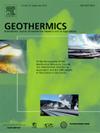用卷积神经网络增强地热岩石学
IF 3.5
2区 工程技术
Q3 ENERGY & FUELS
引用次数: 0
摘要
利用岩石学对地热储层进行定性评价通常是在钻井过程中进行的,以评估储层岩石的渗透率、孔隙度和矿物地温特征,特别是在勘探阶段对地下知之甚少的情况下。岩石学分析包括:直观估计孔隙和脉状组分,识别岩石结构,描述蚀变程度,识别热液蚀变矿物和指示温度,注意剪切作用和各种孔隙类型的存在。这种传统的视觉估计和评估方法在平均视场时容易出错,而且可能需要大量的劳动,特别是在时间敏感的钻井作业中,地质学家必须在偏光显微镜下分析每口井的数百个薄片。根据偏光显微镜下观察到的岩石参数分组,对103个地热岩心薄片进行了孔隙度划分。为了提高岩石学中传统的视觉评价方法,本研究训练并验证了卷积神经网络(cnn)在基于这些参数的孔隙度自动评级和高温岩浆侵入地热系统中关键生产标志绿帘石的检测中的应用。地热井岩心薄片的显微照片被用作训练和验证ResNet、AlexNet和VGGNet架构的输入数据。在平面偏振光(PPL)显微镜下,三种CNN结构的孔隙度分类精度在0.74 ~ 0.84之间,绿帘石检测精度在0.90 ~ 1.0之间。结果表明,cnn在地热井样品评价中可以显著增强传统岩石学。本文章由计算机程序翻译,如有差异,请以英文原文为准。

Enhancing geothermal petrography with convolutional neural networks
The qualitative assessment of a geothermal reservoir using petrography is often conducted during drilling to assess the permeability, porosity, and mineral geothermometry of the reservoir rocks especially when little is known about the subsurface during the exploration stage. The petrographic analysis includes visually estimating pore and vein fractions, identifying rock textures, describing the degree of alteration, recognizing the hydrothermal alteration minerals and indicated temperature, and noting the presence of shearing and various porosity types. This traditional method of visual estimation and assessment is prone to errors when averaging fields of view and can be labor-intensive, especially during time-sensitive drilling operations when a geologist must analyze hundreds of thin sections per well under a polarizing light microscope. In this study, indicated porosity levels were assigned to 103 geothermal core thin sections based on the grouping of the rock parameters as observed under a polarizing light microscope. To enhance the traditional visual assessment in petrography, this study trained and validated convolutional neural networks (CNNs) in the automatic rating of porosity based on these parameters and in the detection of epidote, a key production marker in high-temperature magmatic-intrusive geothermal systems. Photomicrographs of the geothermal well core thin sections were utilized as input data for training and validating the ResNet, AlexNet, and VGGNet architectures. The three CNN architectures achieved porosity classification precision ranging from 0.74 to 0.84, and epidote detection precision between 0.90 and 1.0 in plane-polarized light (PPL) photomicrographs. The results demonstrate that CNNs can significantly augment traditional petrography in evaluating geothermal well samples.
求助全文
通过发布文献求助,成功后即可免费获取论文全文。
去求助
来源期刊

Geothermics
工程技术-地球科学综合
CiteScore
7.70
自引率
15.40%
发文量
237
审稿时长
4.5 months
期刊介绍:
Geothermics is an international journal devoted to the research and development of geothermal energy. The International Board of Editors of Geothermics, which comprises specialists in the various aspects of geothermal resources, exploration and development, guarantees the balanced, comprehensive view of scientific and technological developments in this promising energy field.
It promulgates the state of the art and science of geothermal energy, its exploration and exploitation through a regular exchange of information from all parts of the world. The journal publishes articles dealing with the theory, exploration techniques and all aspects of the utilization of geothermal resources. Geothermics serves as the scientific house, or exchange medium, through which the growing community of geothermal specialists can provide and receive information.
 求助内容:
求助内容: 应助结果提醒方式:
应助结果提醒方式:


